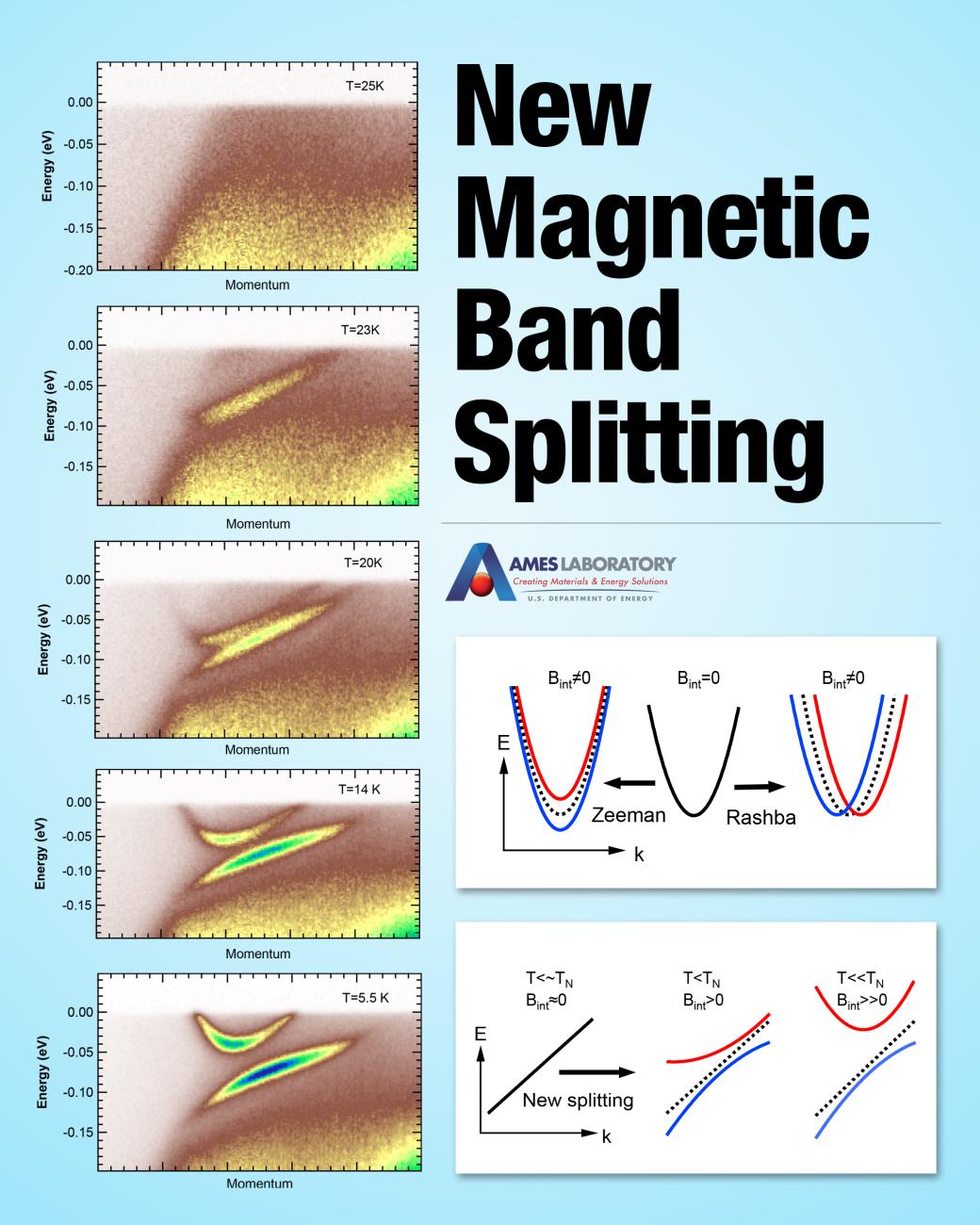Newly discovered Fermi arcs that can be controlled through magnetism could be the future of electronics based on electron spins. These new Fermi arcs were discovered by a team of researchers from Ames Laboratory and Iowa State University, as well as collaborators from the United States, Germany, and the United Kingdom. During their investigation of the rare-earth monopnictide NdBi (neodymium-bismuth), the research team discovered a new type of Fermi arc that appeared at low temperatures when the material became antiferromagnetic, i.e., neighboring spins point in opposite directions.
Fermi surfaces in metals are a boundary between energy states that are occupied and unoccupied by electrons. Fermi surfaces are normally closed contours forming shapes such as spheres, ovoids, etc. Electrons at the Fermi surface control many properties of materials such as electrical and thermal conductivity, optical properties, etc. In extremely rare occasions, the Fermi surface contains disconnected segments that are known as Fermi arcs and often are associated with exotic states like superconductivity.

Right: The top graph shows the known Zeeman and Rashba band splitting behavior. The bottom shows the newly observed band splitting behavior.
Adam Kaminski, leader of the research team, explained that newly discovered Fermi arcs are the result of electron band splitting, which results from the magnetic order of Nd atoms that make up 50% of the sample. However, the electron splitting that the team observed in NdBi was not typical band splitting behavior.
There are two established types of band splitting, Zeeman and Rashba. In both cases the bands retain their original shape after splitting. The band splitting that the research team observed resulted in two bands of different shapes. As the temperature of the sample decreased, the separation between these bands increased and the band shapes changed, indicating a change in fermion mass.
“This splitting is very, very unusual, because not only is the separation between those bands increasing, but they also change the curvature,” Kaminski said. “This is very different from anything else that people have observed to date.”
The previously known cases of Fermi arcs in Weyl semimetals persist because they are caused by the crystal structure of the material which is difficult to control. However, the Fermi arcs that the team discovered in NdBi are induced by magnetic ordering of the Nd atoms in the sample. This order can be readily changed by applying a magnetic field, and possibly by changing the Nd ion for another rare earth ion such as Cerium, Praseodymium, or Samarium (Ce, Pr, or Sm). Since Ames Lab is a world leader in rare earth research, such changes in composition can be easily explored.
“This new type of Fermi arcs appears whenever the sample becomes antiferromagnetic. So when the sample develops magnetic order, these arcs just appear seemingly out of nowhere,” said Kaminski.
According to Kaminski, another important characteristic of these new Fermi arcs is that they have what is called spin texture. In normal metals, each electronic state is occupied by two electrons, one with a spin up, one with a spin down, so there is no net spin. The newly discovered Fermi arcs have single orientation of spin at each of their points. Since they exist only in a magnetically ordered state, the arcs can be switched on and off very quickly by applying a magnetic pulse, for example from an ultrafast laser.
“Having such a spin decoration or spin texture is important because one of the quests in electronics is to move away from the charge-based electronics. Everything that you use now is based on moving electrons in wires and that causes dissipation,” Kaminski said.
The ability to control the spin of electrons relates to a new branch of information technology called spintronics, which is based on electron spin rather than on moving charges along wires.
“Instead of moving a charge, we either flip the orientation of the spin or cause the propagation of the spin along the wire,” Kaminski explained. “These spin changes technically should not dissipate energy, so it doesn't cost a lot of energy to store information as spin or to move information as spin.”
Kaminski emphasized the importance of this finding to the field, but he said there is still a lot of work to be done before these findings can be used in new technology.
This research is further discussed in the paper “Emergence of Fermi arcs due to magnetic splitting in an antiferromagnet,” authored by B. Schrunk, Y. Kushnirenko, B. Kuthanazhi, J. Ahn, L.-L. Wang, E. O’Leary, K. Lee, A. Eaton, a. Fedorov, R. Lou, V. Voroshnin, O.J. Clark, J. Sanchez-Barriga, S.L. Bud'ko, R.-J. Slager, P.C. Canfield, and A. Kaminski; and published in Nature.
Crystal growth and characterization were supported by Center for the Advancement of Topological Semimetals (CATS), an Energy Frontier Research Center funded by the U.S. DOE, Office of Basic Energy Sciences.
Ames Laboratory is a U.S. Department of Energy Office of Science National Laboratory operated by Iowa State University. Ames Laboratory creates innovative materials, technologies, and energy solutions. We use our expertise, unique capabilities, and interdisciplinary collaborations to solve global problems.
Ames Laboratory is supported by the Office of Science of the U.S. Department of Energy. The Office of Science is the single largest supporter of basic research in the physical sciences in the United States and is working to address some of the most pressing challenges of our time. For more information, please visit https://energy.gov/science.
Adam Kaminski, Division of Materials Sciences and Engineering, 515-294-0849
Paul Canfield, Division of Materials Sciences and Engineering, 515-294-6270
September V. Martin, Communication Specialist, svmartin@ameslab.gov
